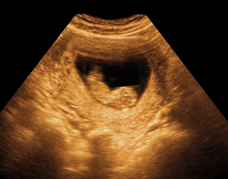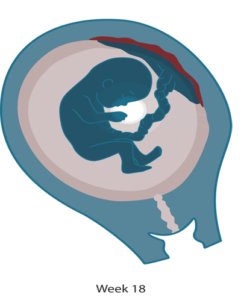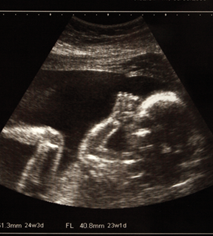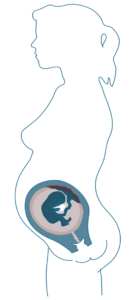Second Trimester
Weeks 13-27
In the second trimester, your baby will grow steadily and the baby’s organs will develop more. The overall size of the baby will increase by four times and its weight will increase by 30 times.
By week 13 your baby’s facial bones are complete and the delicate facial features are more easily recognised. The head is the largest part of the baby but very soon its body growth will catch up.

Your baby at this time is very thin and is covered by a fine translucent skin. Although the eyelids are fully formed, they will stay closed for the most part of the second trimester. Your baby can be seen moving freely on ultrasound scan. The placenta (afterbirth) is formed, which provides oxygen and nutrition from your circulation to the baby. Your baby by the end of week 13 is 6 cm (2.4 inches) long and weighs about 30 grams (1 ounce).
Week 14: Your baby can make a fist and suck its thumb. Your baby’s arms are long enough for its hands to meet together over its body. The amniotic fluid or liquor (sac of water around the baby) is increasing which is important so that your baby is freer to move which helps the baby’s muscles to develop. Your baby’s kidneys start to work. By the end of this week your baby has grown to 7 cm (2.7 inches) and its weight has gone up to 45 grams (1.5 ounces). Over the next few weeks, your baby grows at a regular rate; its legs in particular have an amazing growth spurt and are now longer than the arms. From now on, your baby’s rate of growth of its body and limbs will slow down; however, your baby will continue to put on weight at a steady pace. This physical slow down helps your baby to develop in different ways. For example, its lungs, digestive and nervous systems are slowly maturing.
By the end of week 16: Your baby will measure 9 cm (3.5 inches) and weigh 90 grams (3 ounces).

Week 18: It is possible that you are now feeling your baby kick for the first time. In the beginning you may think it is ‘wind’ until you realise there is a pattern to these gentle movements. Your baby at this stage can know the difference between sweet and bitter flavours as its taste buds are developed. Your baby can open its mouth and stick out its tongue, which you can often see on ultrasound. A very fine hair called lanugo covers the baby’s entire body; it is thought that this helps to keep the baby warm until it has enough fat stores.
At 19 weeks your baby’s teeth are formed in its gums. Your baby can hear sounds from outside your body and will respond if you play loud or easy music. All these developments in your baby’s senses are due to the fact that its nervous system is developing and maturing.
By the end of the 20th week your baby measures 13 cms (5 inches) and weighs 240 grams (8 ounces). Most women are aware of their baby’s movements around this time.
By 24 weeks your baby is 17 cm (6.5 inches) long and weighs about 500 grams (17.5 ounces). Your baby is able to open and close its mouth and can swallow a large amount of amniotic fluid.
By the 26th week the volume of amniotic fluid has increased to about 500 mls. Even though your baby’s lungs are not quite fully developed, the baby has now reached a level of development where it may survive outside the womb with the help of specialist care in the neonatal unit.

In the weeks leading up to week 28, important developments are happening inside your baby’s body. Because your baby’s nervous system and skeleton are developing more, the baby’s movements become more deliberate. Your baby can move freely, somersault and hiccough. It is even thought that the baby can tell the difference between you and your partner’s voice. You will also notice a pattern between your baby being asleep and awake; however, this often does not match your own every day and night pattern.
Your changing body:
 Now that you are in the second trimester of your pregnancy, you will be much more confident that your baby is a reality. You will probably feel less sick and start to get more energy back into your life. You will also notice that your waist is beginning to get bigger and a bump is beginning to form in your tummy. You can get increased pigmentation of your skin at this time and as a result you will notice the area around your nipples (areola) will become darker. Also, a dark line may form down the centre of your tummy, which is called linea nigra, and moles and birthmarks will also get darker. All these changes are very normal and happen because you have more of the hormone oestrogen in your body.
Now that you are in the second trimester of your pregnancy, you will be much more confident that your baby is a reality. You will probably feel less sick and start to get more energy back into your life. You will also notice that your waist is beginning to get bigger and a bump is beginning to form in your tummy. You can get increased pigmentation of your skin at this time and as a result you will notice the area around your nipples (areola) will become darker. Also, a dark line may form down the centre of your tummy, which is called linea nigra, and moles and birthmarks will also get darker. All these changes are very normal and happen because you have more of the hormone oestrogen in your body.
There is a huge increase in how much blood goes around your body. For example, at the beginning of the second trimester 25% of your blood is directed to your womb in order to support your growing baby and placenta (afterbirth). Just 2% of your blood volume went to your womb before the pregnancy. Because of this some women will feel their heart beating faster and may complain of having palpitations. As your womb continues to grow you may notice that you develop stretch marks on your tummy and/or around your breasts. This is caused by the collagen beneath the skin tearing as it stretches, as your body gets bigger. There are a number of lotions and creams that you can buy, which may help to reduce the effects of the stretch marks. You will also find that you will feel hungrier as you start to enjoy your meals again. It is important that you eat a well balanced diet and remember that it is the quality of the food rather than how much you eat that counts.
Things to do:
- Go to the hospital or midwife in the community for your first antenatal visit.
- Tell your family and friends that you are pregnant.
- Tell your employer that you are pregnant and apply for maternity leave.
- Make a conscious effort to cut down or stop smoking, drinking alcohol and/or taking drugs.
- Have a balanced diet and keep fit.
- Sign up for parent education classes.
- Visit the dentist for a check-up.
- If you are pregnant during the flu season (October to March/April), you should get the seasonal flu vaccine from your GP.
